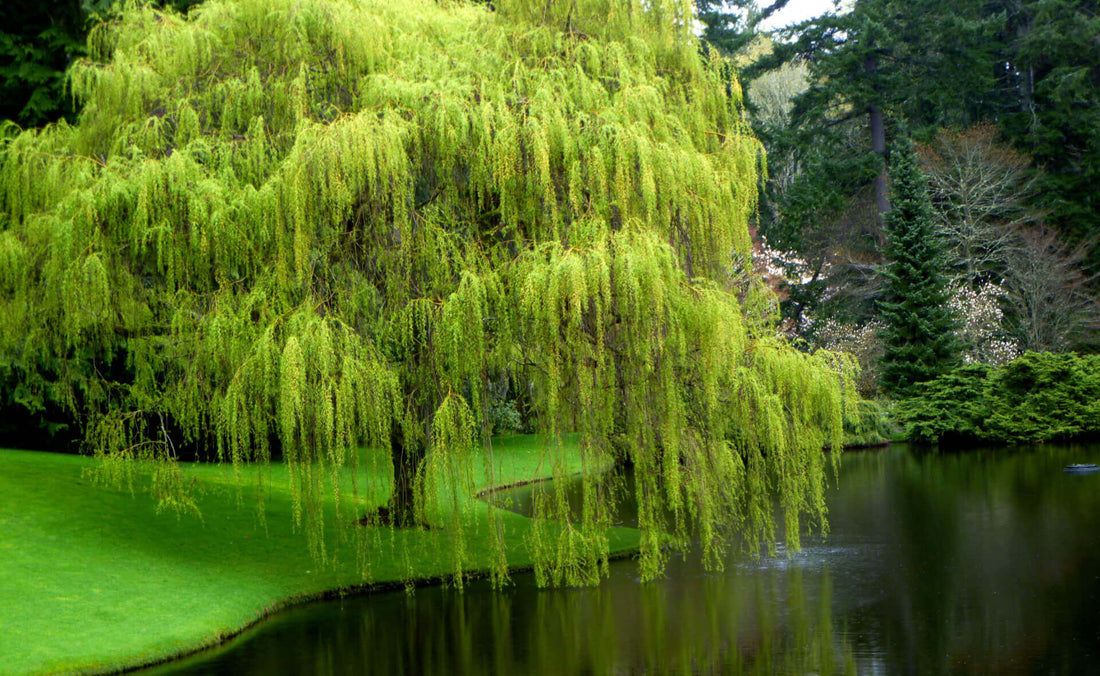
The Versatile Beauty of Weeping Willow Trees
Share
Nature's Graceful Water Feature Enhancement
The Weeping Willow (Salix babylonica) is a deciduous tree known for its graceful, drooping branches and soft, elongated leaves. Due to its elegant appearance and the way its branches seem to "weep" toward the ground, it is often associated with beauty and melancholy.
Versatility in Landscape Design
One of the most remarkable aspects of weeping willow trees is their versatility in landscape design. These elegant trees can thrive in various environments, making them suitable for both urban and rural settings.

Whether planted near a backyard pond, along a riverbank, or in a city park, weeping willows add an enchanting touch to any landscape. Weeping willows often create natural boundaries, offering privacy and seclusion. Their drooping branches create a serene curtain separating spaces and providing a sense of enclosure without artificial barriers. Moreover, their roots can help stabilize soil along riverbanks and prevent erosion, making them valuable additions to waterfront properties.
Rapid Growth Rate
Weeping willow trees are known for their astonishingly fast growth rate. They can grow up to 6 feet or more in a year, a testament to their vitality and resilience. This rapid growth makes them ideal choices for those seeking quick results in their landscaping projects. They sometimes reach full height within 15-20 years, but they have a relatively short lifespan compared to other trees (about 40-75 years).
Weeping willows thrive in moist, well-drained soils and are often found near rivers, lakes, and ponds. They tolerate many soil types, though they prefer full sunlight.
Due to their extensive root systems, weeping willows often stabilize soil near water bodies and prevent erosion.
Enhancing Water Features
Whether it's a small pond in a residential garden or a grand lake in a public park, the presence of a weeping willow tree can dramatically transform the ambiance. The pendulous branches of weeping willows gracefully drape over the water, creating a mesmerizing reflection on the surface below.
The gentle rustling of the leaves in the breeze and the soothing sound of water meeting branches combine to create a sensory experience that is both tranquil and captivating. It's no wonder that many homeowners and landscape architects choose weeping willows to elevate the appeal of their water features.
Their dense foliage provides shelter for birds and small mammals, and their branches can offer shade and protection for fish when grown near water. In urban areas, weeping willows near artificial ponds and fountains provide a serene oasis amid the hustle and bustle of city life.
The Dense Canopy
Weeping willows have long, slender branches that arch downward, creating a canopy of sweeping green leaves. The leaves are typically narrow and light green and turn yellow in autumn before falling.
The dense canopy offers shade and respite from the sun's scorching rays. This makes them popular for picnic spots, outdoor gatherings, and relaxation areas.
The dense canopy also acts as a haven for wildlife. Birds, squirrels, and other creatures often find refuge in the protective embrace of weeping willow branches. The tree's twigs and leaves provide nesting materials and food sources for various wildlife, fostering biodiversity in the surrounding ecosystem.
Aesthetic Appeal and Cultural Significance
The tree is often associated with mourning, sadness, and reflection, partly due to its drooping appearance. The weeping willow has been linked to grief and memorials in various cultures.
Weeping willows have appeared in literature and art for centuries, frequently symbolizing sorrow, melancholy, and the passage of time.
Their presence in gardens and parks often symbolizes peace and introspection, inviting individuals to connect with nature and find solace in its embrace.
The weeping willow's beauty, grace, and cultural associations make it a beloved tree worldwide, particularly in landscapes where its elegant form can be fully appreciated.
